The Apple iPad Air 2 Review
by Joshua Ho on November 7, 2014 9:30 AM EST- Posted in
- Tablets
- Apple
- Mobile
- iOS
- ipad Air 2
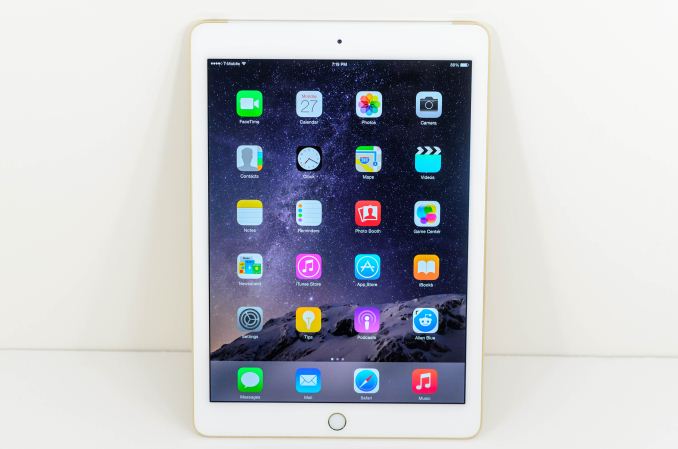
As we approach the holidays, Apple has launched a new iPad as expected. As one might expect from the name, the iPad Air 2 is more of an evolution of the original iPad Air than a clean-sheet design. This doesn’t mean that there’s little to talk about though, as Apple has gone a long way to improve every aspect of the iPad Air with this iteration. However, with this generation Apple seems to be under fire as Google attempts to push into the premium tablet space with the Nexus 9.
Without question though, the iPad line defines what an ARM-based tablet is. The iPad Air 2 is undoubtedly a part of this lineage with its focus on a large touch-screen display. This level of design minimalism is responsible for at least part of the original reaction to the tablet as a “large phone”. However, by virtue of its sheer size there are new possibilities opened up in terms of content consumption and even content creation. In the basic definition of a tablet, the iPad Air 2 definitely fits. There’s a new SoC, more RAM, a better display lens, new cameras, and an even thinner design, but all of these things don’t change the fact that this is a 9.7” display that can only be interacted with through a touchscreen. In the interest of saving space and time, I’ve included a spec sheet below to cover all bases.
| Apple iPad Air 2 | |
| SoC | 3x 1.5 GHz CPU A8X |
| RAM/NAND | 2GB LPDDR3 + 16/64/128GB NAND |
| Display | 9.7" 2048x1536 IPS LCD |
| Network | WiFi only or 2G / 3G / 4G LTE SKU |
| Dimensions | 240 x 169.5 x 6.1 mm, 437g WiFi, 444g LTE |
| Camera | 8MP Rear Facing with F/2.4 aperture, 1.3MP FFC |
| Battery | 7340 mAh (27.62 Whr) |
| OS | iOS 8.x |
| Connectivity | 802.11a/b/g/n/ac + BT 4.1, USB2.0, GPS/GNSS |
As with any other mobile device, one of the most immediate impressions one can form is that of design. This may be one of the most important areas as well, because every mobile device is constantly held or otherwise handled. These devices tend to be deeply personal as well, which means that there’s a great deal more emphasis on industrial design than a desktop tower that gets shoved into a dark corner for five years at a time.
To this end, the iPad Air 2 does quite well. The design is definitely separate from the iPhone 6 line, as the metal chamfer remains, but the form continues to be quite pleasing. On the front face of the tablet, we see a single 1.2MP camera, the display, and the home button which has TouchID built in. The glass is flat, which makes it seem noticeably different from the iPhone 6 line in that regard as it meets the chamfered edge of the back cover rather than making a seamless curve. The radius of the curve is also noticeably different as a result, simply curving in towards the center of the device rather than curving out of the device. If anything, this does make the iPad Air 2 feel a bit thicker in the fingers but the device overall is still incredibly thin.
Speaking of the back cover, there’s really almost nothing to speak of on the back cover. There’s the 8MP camera and a microphone hole, but not much else other than the large plastic RF window on the top edge of the tablet. The curve of the sides does make it seem like there’s a great deal more on the back cover though. Other than the RF window, there’s a power button and 3.5mm jack on the top of the tablet. Next to the power button are the volume buttons, but curiously no mute/lock rotation switch for this generation. I suspect that the reasons for this deletion are primarily due to user confusion, although my experiences are purely anecdotal in this regard. Finally, along the bottom of the device we see the Lightning port and two speaker grilles.
Overall, the design of the iPad Air 2 is impressive. The thin feel is really quite impressive when compared against other devices, but the weight no longer feels quite as incredible as the original iPad Air when compared to the iPad 4.
Outside of the physical design, Apple has also included a selection of two cases which include the smart cover and case, which are mostly unchanged from the previous generation except to fit the iPad Air 2. I don’t have much to complain about here although the smart case has a bit more flex on the sides than I’d like. The smart cover does have enough strength in the magnets to hold the tablet by the cover, although I wouldn't recommend doing this.


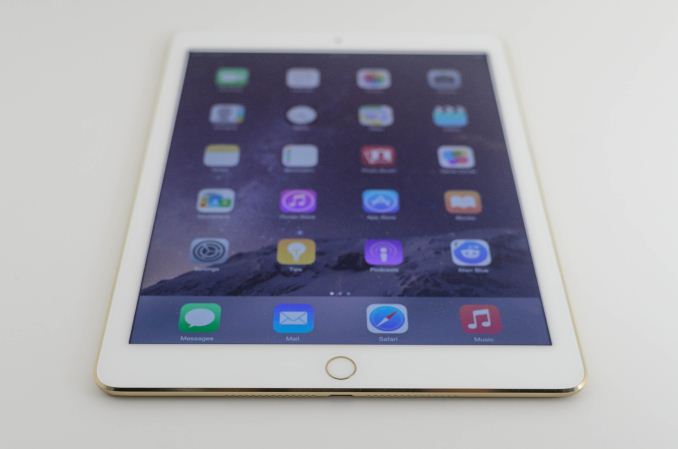
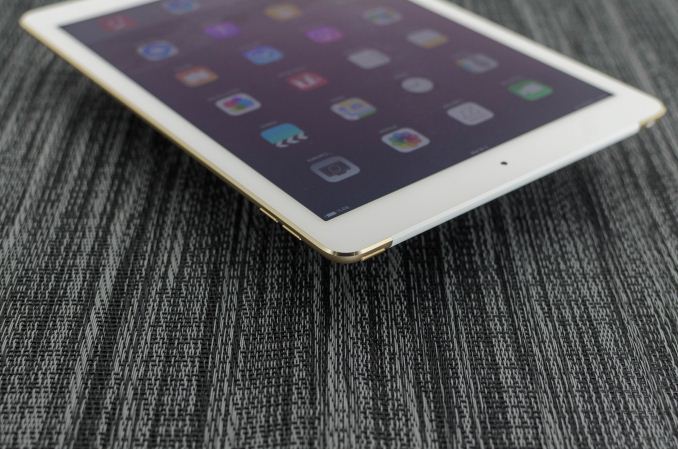
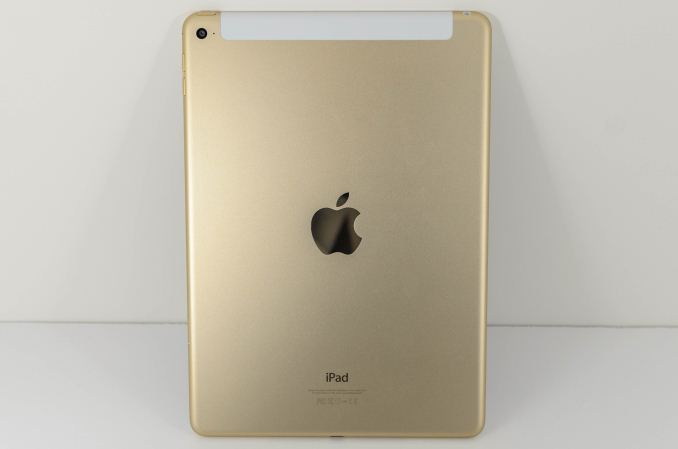

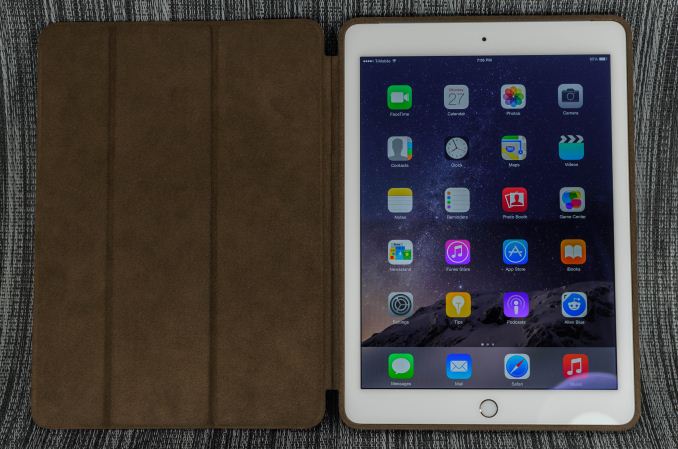








226 Comments
View All Comments
wewewe - Friday, November 7, 2014 - link
Just received mine. Previous was an Ipad 4th gens. One word ! Wow !! This is really magical. Its thin piece of glass with a processing power of a computer. I doubt there is a better tablet experience than this.Hyper72 - Friday, November 7, 2014 - link
I replaced an iPad 2 (512MB RAM) with Air 2, imagine my wow experience...Yes I also enjoy the thinness more than I thought I would. Only using it ~ two hours a day means it has more than plenty juice in any case.
Klug4Pres - Friday, November 7, 2014 - link
" While tablet applications that haven’t been properly scaled on the iPhone line are likely to look horrible due to the scaling factor used. While the same can and does happen with Android apps, it isn’t nearly as obvious because most of the scaling done is far more seamless and simply leaves a great deal of white space in the application that can’t necessarily be used."Please tidy that up by using actual sentences, because it is difficult to understand what you are saying here.
"As a result of all this work, it seems pretty obvious that the iPad Air 2 continues to deliver some of the best tablet software on the market. For the most part, every application available seems to effectively deliver a tablet-specific experience that helps to set the iPad lineup apart from other tablets. Unfortunately, it seems that due to a lack of competition there isn’t much in the way of attempts to dramatically improve the software experience, and as a result it’s a bit difficult for me to justify carrying a tablet around all the time as its size is relatively massive compared to even a 6 inch phablet"
You are saying the iPad Air 2 has some of the best tablet software, but tablets in general are not worth carrying around because they are too big relative to phablets. You attribute this to a lack of competition for the iPad, which means Apple has failed to make dramatic improvements to tablet software, improvements that would be necessary to make it worthwhile to carry tablets. OK. What about just having one for use at home? I think you are trying to say too many unrelated things in this paragraph.
"Overall, the iPad Air 2 is likely to be one of the only tablets worth buying on the market today."
I think this is rather too sweeping a statement for a review focused on one tablet, not very helpful when you omit to mention the other tablets worth buying, and anyway the statement isn't well supported in the article itself.
name99 - Friday, November 7, 2014 - link
"The glass is flat, which makes it seem noticeably different from the iPhone 6 line in that regard as it meets the chamfered edge of the back cover rather than making a seamless curve."iPad manufacturing has always lagged iPhone, I imagine because the volumes are lower.
I wouldn't read any "statement of direction" into this.
For example my iPad Retina came out at the same time as the iPhone 4/4S. The 4/4S was incredibly slick for its time, while the iPad Retina used a sort of lacquer or something to form the bezel around the screen, and there was noticeable unevenness in this lacquer. (Uneven meaning not visible, but you could feel it if you ran your fingers over the bezel.)
Of course the iPhone 5 ramped up slickness of manufacturing to a new level with the really tight tolerances, the feel of a single block of material; the 6 retained that while now converting straight edges to curves. I'd say the iPad Air 2, in terms of manufacturing slickness lives halfway between the 4/4S and the 5/5S. It doesn't QUITE reach that feeling of a single uninterrupted block of material, probably because it's striving for curves --- they might have been able to make it if they'd gone for a look exactly like the 5/5S.
The larger pattern, I think, is that the manufacturing/fit-and-finish is improving for iPads every year; they just suffer in comparison with the absolute perfection of the phone manufacturing.
sporkfan - Friday, November 7, 2014 - link
In agreement with you here. I'm really not a fan of how the TouchID is integrated into the iPad Air 2. I'm not sure if it's just lower tolerances than the iPhone 5s, or perhaps my unit is weird. But if my fingernails are long enough that they contact the ring at all (not that long, I swear!), they catch on the sharp outer edge. It feels icky. On the iPhone 5s this is totally not an issue.feeblegoat - Friday, November 7, 2014 - link
Hey, Josh, the data doesn't really match your conclusions about efficiency too much. I can see that performance degraded slightly more on the shield tablet, but only at the very end, before the last ten minutes. Up until then, performance stays at a steady 57fps (http://www.anandtech.com/show/8329/revisiting-shie... However, considering that this is an onscreen test, I'll assume the 5-7 fps advantage compensates for the lighter workload given by the lower resolution screen. So, assuming the workload is even, then we must consider the battery size difference. Ignoring the screen power usage for now, the Shield Tablet has a 19.75 Wh battery, the Air 2 a 27.62 Wh battery. Ratio the battery numbers with the battery life difference, and we end up looking at a 23% efficiency win for the Air 2, maybe up to 25-28% because of the larger screen. That's a little less than I would actually expect (but pretty close to expectations) considering the A8X is 20nm and the K1 28nm. So if anything, praise the efficiency of 20nm; because considering the gap in architecture, the efficiency is maybe worse than the K1's GPU.Sidenote: (Of course, that's a somewhat invalid argument, because the A8X has 20nm, K1 doesn't, and we can't just say that the K1 is more efficient - it's not. But still, the difference is due to 20nm. Kudos to Imagination, though, for making a GPU that has similar hypothetical efficiency to the juggernaut Nvidia. Can't wait for Maxwell SoC's though. One SMX on a phone?)
techconc - Friday, November 7, 2014 - link
"Ignoring the screen power usage for now"Huh? Once you do that, the rest of your question is meaningless. The screen is the largest power consuming component by a large margin. What's more, you're comparing a device with a 5" screen to a device with a 10" screen and attempting to guess at the efficiency of the chip components based the the respective battery sizes for these devices. That's an exercise in futility as you're not able to draw any meaningful conclusions based on the data you have.
lucam - Friday, November 7, 2014 - link
He doesn't get..so be it..dwade123 - Friday, November 7, 2014 - link
Lol Android devices are nowhere close to the iphone 6 let alone Air 2 in raw power and app library.Morawka - Friday, November 7, 2014 - link
Thanks for the review! finally ! haha